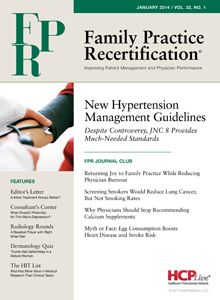Publication
Article
Family Practice Recertification
Screening Smokers Would Reduce Lung Cancer, But Not Smoking Rates
Author(s):
While annually screening a carefully selected population of current and former smokers will result in decreased lung cancer and all-cause mortality, the intervention will not lead to a decrease in smoking.
Frank J. Domino, MD
Review
Humphrey LL, Deffebach M, Pappas M, Baumann C, Artis K, Mitchell JP, Zakher B, Fu R, Slatore CG. Screening for lung cancer with low-dose computed tomography:
a systematic review to update the US Preventive Services Task Force recommendation. Ann Intern Med. 2013 Sep 17;159(6):411-20. http://annals.org/article.aspx?articleid=1721248.
Study Methods
Though 4 trials evaluating low-dose computed tomography (LDCT) screening for lung cancer were included in this systematic review, the National Lung Screening Trial (NLST)1 provided the most data for analysis. The trials were as follows:
- The NLST trial was a good-quality study that compared 3 annual LDCT scans to 3 annual single-view posterior—anterior chest radiographs in asymptomatic men and women aged between 55-74 years old who were current or former (<15 years since quitting) smokers (≥30 pack-years).
- The Detection and Screening of Early Lung Cancer by Novel Imaging Technology and Molecular Essays (DANTE) trial was a fair-quality Italian trial that compared usual care with the addition of 4 annual LDCT scans to usual care without LDCT among males aged between 60-74 years old who were current or former smokers (≥20 pack-years) without significant comorbid conditions.
- The Danish Lung Cancer Screening Trial (DLCST) was a fair-quality, 5-year, single-center trial comparing 4 annual LDCT screening to no screening in healthy men and women aged between 50-70 years old who were current or former smokers (≥20 pack-years) and were able to walk up at least 36 stairs without stopping. Former smokers must have quit after age 50 and less than 10 years before enrollment.
- The Multicentric Italian Lung Detection (MILD) study was a poor-quality, single-center trial comparing annual or biennial LDCT screening to no screening in men and women aged 49 years or older who were current or former (<10 years since quitting) smokers.
Results and Outcomes
In the NSLT trial, lung cancer and all-cause mortality were reduced by 20% and 6.7%, respectively, in LDCT patients compared to the chest radiography group after 6.5 years of follow-up. Though the 3 smaller European trials found neither benefit nor harm from LDCT screening, they were underpowered and too short in duration to be included in the analysis.
The harms of LDCT described in the trials included radiation exposure, overdiagnosed lung cancer that would never have become symptomatic, and a high rate of false-positive findings, which were typically resolved with further imaging.
In terms of screening accuracy, the false-positive rate in the first round of screenings was just under 25% having at least 1 abnormality, and only 4% of those patients were diagnosed with lung cancer.1 This implies a positive predictive value (PPV) of 4%, which means 96% of those with abnormal results were false positives. Despite this finding, the rates of smoking cessation were unaffected.
Conclusion
Annual LDCT screening in a carefully selected population of current and former smokers at a high risk for lung cancer will result in decreased lung cancer and all-cause mortality.
Commentary
This systematic review derived its conclusion from a singular study from the National Lung Screening Trial Research Team, which found lung cancer death and all-cause mortality can be improved when inclusion criteria are closely followed, protocol for screening is standardized, and follow-up of abnormal findings — from abnormal CT scans to treatment protocols — are managed to 100% of the documented specifications to limit intervention.
Critics of this recommendation are concerned about the costs it incurs, the risk of overdiagnosis, and the management of abnormal findings. Most profoundly, the intervention did not lead to a decrease in smoking despite its high false-positive rate.
Quandaries abound for family physicians.
First, this recommendation advises only screening those who meet the inclusion criteria, meaning 55- to 80-year-old current smokers or former smokers who have quit within the past 15 years with a ≥30 pack-year smoking history and no comorbidities that limit life expectancy. So what will family practice folks do with the rest of the patients who fall outside of the screening criteria? Hopefully, they will apply aggressive smoking cessation counseling techniques. It’s unlikely that patients would be willing to pay out of pocket for this yearly screening, so counseling is the most important method to deal with those outside of protocol.
Next, there are concerns regarding the management of abnormal results. With 1 in 4 patients having an abnormal scan — and only 4% of these scans being truly positive1 — family physicians will question how to handle one, especially since abnormal results will add a malpractice risk to the physician and greater cost to society. The most common approach to an abnormal result that does not overtly appear to be a cancer is a repeat radiologic study, which again incurs costs and radiation exposure. Your office will be sent the result of this screening test, so be prepared to set aside time to meet with these folks and counsel them.
Finally, in those few patients in whom a cancer is found, what is the best treatment protocol: genetic testing, chemotherapy, surgery, or all three? Lung cancer is not a singular disease entity, and no uniform approach to its management is universally known or practiced. Likewise, what is the best way to approach patients in whom a tumor is found, but chance of treatment benefit is very small? Should they be aggressively counseled on hospice care?
To assist with patient counseling, researchers from the Prostate, Lung, Colorectal, and Ovarian (PLCO) screening trial developed 3 lung cancer risk-prediction tools involving former and current smokers, which they summarized in an Excel-based risk calculator that can be downloaded for free to help patients and clinicians discuss the risk of lung cancer development. The first tool is meant to help patients predict their risk of developing lung cancer over the ensuing years, while the other 2 calculators help determine the likelihood that a nodule found on screening is a cancer.
Many are concerned about the cost of such a screening program, since smoking and the subsequent development of lung cancer is a value-based decision, as compared to the development of breast cancer. The US Preventative Services Task Force (USPSTF) offers modeling estimates that show this screening is cost-effective and beneficial for both patients and society, but only if the protocols for diagnosis, follow-up, and treatment meet 100% compliance.2
This degree of uniformity is unlikely to take place in most community settings. Just compare it to the facts that:
- Breast cancer screening is often started before the recommended 50 years.
- Prostate cancer screening still occurs.
- Osteoporosis screening frequently occurs far earlier than the recommended age of 65 years.
If aggressive smoking cessation programs funded by insurance companies were the comparator, would LDCT scanning still be the recommendation for smokers?
First and foremost, clinicians should use motivational interviewing techniques to encourage smoking cessation. Tobacco use causes a variety of cancers, including lung cancer, so addressing cessation is critical. Sadly, LDCT had no positive impact on smoking cessation in this study.
Next, physicians should create a standardized approach to help those who want to quit. One very successful method is to tell patients their “lung age.”3 This is a pulmonary function calculation that allows patients to compare their chronological age with an estimate of their lungs’ age, which is diminished due to smoking. It requires the purchase of a pulmonary function machine that prints results and is easily completed by an outpatient medical assistant. In a family practice office, the current return on investment for this reimbursed tool is less than 35 patients; thereafter, it will generate income.
Lastly, clinicians should use a standardized tool to offer an informed consent discussion with patients who meet inclusion criteria and may be open to screening. One informative handout to keep on hand is the “Patient and Physician” guide from the National Cancer Institute, though another great patient education tool is offered by the Dartmouth-Hitchcock Norris Cotton Cancer Center. Consider utilizing both when you’re discussing lung cancer screening with patients.
It will take years to find out whether screening in the general population saves lives. What’s certain is the costs will be great and they will come from many directions, including radiology suites, specialist visits, hospitals, and malpractice attorneys. For now, help your patients make the best decision and offer them reassurance and more time in your schedule when the abnormal results start coming in.
References
1. The National Lung Screening Trial Research Team. Reduced lung-cancer mortality with low-dose computed tomographic screening. N Engl J Med. 2011 Aug 4;365(5):395-409. http://www.nejm.org/doi/full/10.1056/NEJMoa1102873.
2. de Koning HJ, et al. Benefits and harms of computed tomography lung cancer screening strategies: a comparative modeling study for the US Preventive Services Task Force. Ann Intern Med. 2013 Dec 31. http://www.uspreventiveservicestaskforce.org/uspstf13/lungcan/lungcanmodelstudy.htm.
3. Parkes G, Greenhalgh T, Griffin M, Dent R. Effect on smoking quit rate of telling patients their lung age: the Step2quit randomised controlled trial.
BMJ. 2008 March 15; 336(7644): 598—600. http://www.ncbi.nlm.nih.gov/pmc/articles/PMC2267989/.
About the Author
Frank J. Domino, MD, is Professor and Pre-Doctoral Education Director for the Department of Family Medicine and Community Health at the University of Massachusetts Medical School in Worcester, MA. Domino is Editor-in-Chief of the 5-Minute Clinical Consult series (Lippincott Williams & Wilkins). Additionally, he is Co-Author and Editor of the Epocrates LAB database, and author and editor to the MedPearls smartphone app. He presents nationally for the American Academy of Family Medicine and serves as the Family Physician Representative to the Harvard Medical School’s Continuing Education Committee.





